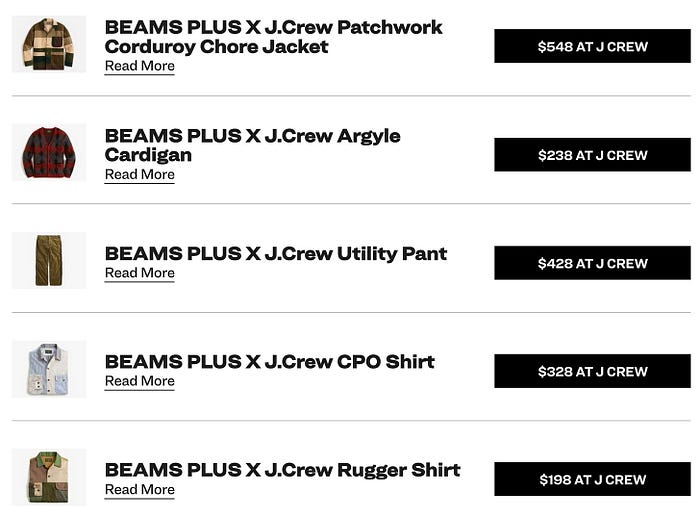J.Crew: Two brands?
Different approaches to menswear and womenswear

Will they or won’t they? The question of success of J.Crew’s revival has been going around the U.S. retail industry ever since Brendon Babenzien was appointed the creative director of menswear and Olympia Gayot head of womenswear. Since then, we’ve seen both Giant Fit Chinos and the rise of Olympia as a star style influencer.
Beyond being the two different tactical approaches (a hero product and a hero person), these are the two separate revival trajectories for reinstating the brand into cultural consciousness, if not immediate profitability.
These approaches differ in their product and creative strategy and their business and brand models.
J.Crew Menswear
Babenzien comes from streetwear labels Supreme and Noah. Collaborations are streetwear’s modus operandi, and Babenzien has so far created cultural ripples through J.Crew x Beams Plus and J.Crew x Tracksmith collaborations. The emphasis is less on the entire collection and more on individual items — hypebeast blogs covered patchworks corduroy chore jackets, utility pant, CPO shirt. This builds upon J.Crew’s much-hyped release of Giant-Fit Chinos that were both immediately sold out and immediately and repeatedly covered by menswear bloggers.

This hero product-driven approach impacts J.Crew’s menswear creative strategy: the emphasis is on the drip model, where items are released at regular, if random, intervals and where products are given priority creative treatment (both Beams Plus and Tracksmith collaborations have their own landing pages). Creative direction is different than for the rest of the site and product assortment. Product-driven approach creates covetable hero items that go beyond the brand’s “regular” audience and aims to connect with menswear collectors, connoisseurs, hypebeasts and aficionados. It’s a smart and targeted approach, as it is focused on influencing culture through people who have a say in it and influence others.
J.Crew’s menswear business model is hybrid, as it mixes considered consumption of status-signaling products (Giant-Fit Chinos) with mass consumption of standardized products (regular chinos).

This bifurcated business model works for two reasons:
- It still services the core J.Crew customer (the one looking for inoffensive workwear and preppy-inspired basics), but it adds aspirational dimension to menswear consumption. Getting a chino pants feels more aspiring when they are made in giant fit.
- It attracts a more discerning, modern and younger menswear customer that would not consider J.Crew, if it weren’t for Beams Plus or Tracksmith collaborations. They may stop there; most likely, they will also explore other product categories as well.
J.Crew Womenswear
Gayot has been with the brand for a while before being promoted to the Head of Womenswear design. Tall, blond and slim, she represents a particular type of Tribeca Mom influencer who is appealing both to the rich neighborhood crowd and to their aspirational suburban counterparts. Gayot is a perfect style influencer, approachable, inoffensive and risk-averse, but fun and colorful enough to emit the youthfulness and taste. Her looks are trendy, but not too trendy; they are classic and timeless with a nod to the zeitgeist. Since her appointment, Gayot Instagram account soared in the number of followers, and her presentation also sharpened. It is less of a feed, and more of a carefully curated lifestyle.
Read the rest of this analysis on The Sociology of Business.
